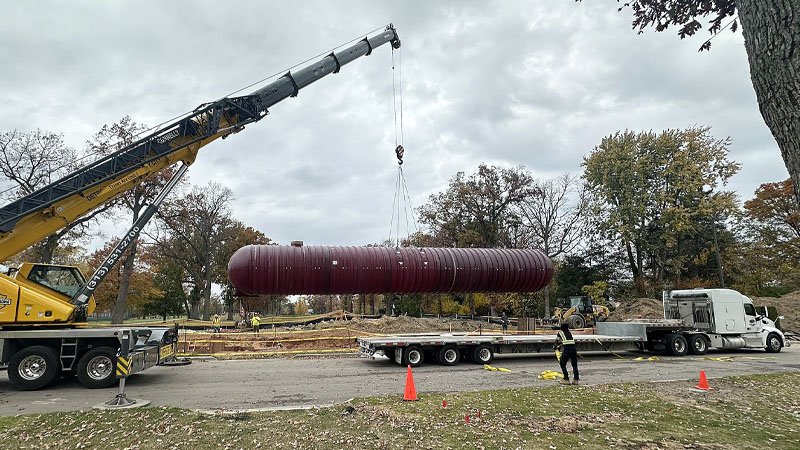When a fire destroyed the clubhouse at Oakland Hills Country Club in suburban Detroit two years ago, other golf facilities in Michigan set about the task of making sure they were not destined for a similar fate.
An assessment of the fire-suppression system at Detroit Golf Club revealed that it likely lacked the water pressure necessary to combat a similar disaster in its 100-year-old clubhouse.
 To make sure the club would be prepared should a fire occur, it is putting the finishing touches on a new state-of-the-art fire-suppression system.
To make sure the club would be prepared should a fire occur, it is putting the finishing touches on a new state-of-the-art fire-suppression system.
The system includes a pair of massive underground storage tanks that will feed overhead sprinklers in the clubhouse if and when needed. Each tank measures 75 feet in length and has a capacity of 40,000 gallons and also can be accessed outside at the source by firefighters if water is needed for an emergency elsewhere on the property.
"After the fire at Oakland Hills, insurance companies looked at everyone's fire-suppression system," said DGC superintendent Sam Moynihan (at right). "We didn't have the pressure we needed."
DGC has cast a wide net to complete the upgrade project that is taking place when there already is a lot taking place at the club, so a committee of members has been enlisted to lend their expertise.
I've been involved with a lot of construction projects before, but I've never done a fire-suppression project. . . . When I first heard what we were doing, I immediately was thinking back to Tonka toys in the sandbox.
The 36-hole club, which first opened in 1899, is in the midst of developing a master plan and eventual restoration by architect Tyler Rae.
The complicated and time-consuming fire-suppression project began in early October and is scheduled to be completed around Thanksgiving, said Moynihan.
"We have quite a few members who have experience in engineering projects like this," said Moynihan. "We're able to make sure we're not missing anything."
The system comprises a new and updated connection to the city water main that results in improved water volume and connects to a pair of underground tanks being installed near the clubhouse and practice green. Each 75-foot-long tank measures 12 feet and together offers a combined 80,000 gallons of water.
The tanks are constructed from durable, lightweight fiberglass and are connected to each other for a total capacity of 80,000 gallons. The system works on a gravity-feed system that features intake connections to the main at the top and a pump at the bottom. In between the tanks that are pitched slightly to assist gravity are a system of sensors and pumps that will deliver plenty of water at the desired pressure.

The system was designed by PEA Group, a Detroit civil engineering firm, and the tanks were built by Xerxes Corp. of Minneapolis. Blaze Contracting, a Detroit construction firm, is moving the dirt and doing the heavy lifting — literally.
Moynihan has been soaking up knowledge from all parties involved in the project, from planning to installation for any tips that can come in handy in future construction projects.
"I've been involved with a lot of construction projects before, but I've never done a fire-suppression project," Moynihan said.
"When I first heard what we were doing, I immediately was thinking back to Tonka toys in the sandbox. This has been an interesting project to be involved in. I've been picking their brains about everything."
Before the system is buried, a series of tests of all lines will be conducted to ensure the proper volume and pressure is produced and there are no leaks anywhere in the system.
We have quite a few members who have experience in engineering projects like this. We're able to make sure we're not missing anything.
The tanks will be strapped to underground concrete ballasts called deadmen to prevent them from moving if groundwater infiltrates the area.
Because they have to be accessible for inspections and repairs, the 12-foot-high tanks are buried to a depth of 8-10 feet with access points at the top of each, and each also will have vent tubes to relieve pressure if the tanks become damaged. That also means that mounds 3 feet high and 75 feet long will be new fixtures near the clubhouse and practice area.
Once in the ground, the tanks rest upon a 6-inch layer of angular gravel, known as #57 Stone, that also helps stabilize the tanks. Then more #57 Stone is filled in around the sides of the tank for support and stabilization, and a cover will be placed on top to preserve the integrity of the gravel before finally covering them with a couple of feet of native soil.
"The angular gravel prevents the tanks from shifting," Moynihan said.
"I hope when this is finished I can find a sod farm to cut some before they close for winter so I can get the area covered."

